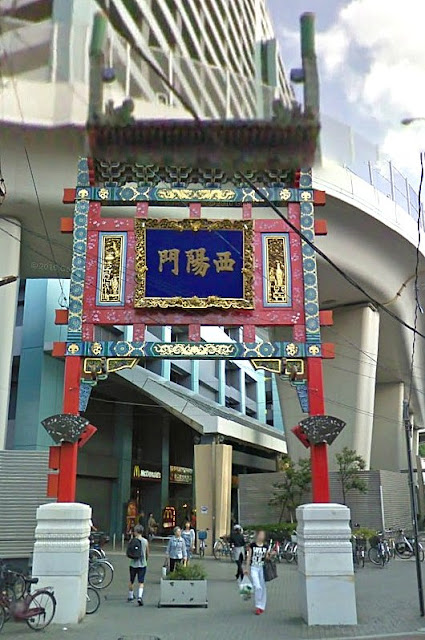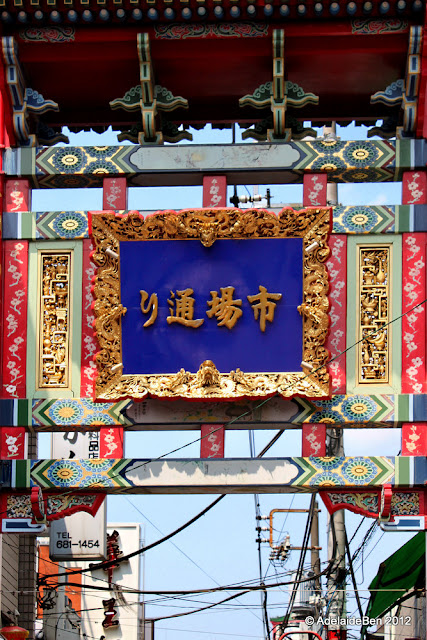Chinatown is approached through a number of gates, or mon in Japanese (門), in traditionally flamboyant style... though they can be slightly odd, sitting in amongst the normal traffic signs. There are 10 gates all up in Chinatown, arranged according to the Chinese art of Feng Shui - bascially a throwback to the ancient beliefs relating to superstition to shape, structure and colour. The first four are the most important, relating to the Four Symbols in the Chinese Constellation. Whilst it was my intent to take snaps of them all, the reality was that the oppressive heat beat me. So here's just a few of the shots that I did manage to take before heat exhaustion threatened to get to me. I've also made use of Google StreetView to help with the rest... it's kinda cheating, but... I've also made use of the info on the official Chinatown website - though unfortunately this part is in Japanese only.
I've made up the map below so you can reference the gates by numbers (in no particularly meaningful order):
 |
| Map care of Google Maps. |
1. The East (東) Gate or Chouyou-mon (朝陽門). This gate relates to the Azure Dragon God, and brings prosperity. The Azure Dragon is said to relate to the East, and Spring - and is associated with the wood element. It was only opened in 2003, and is the largest of the gates.
 |
| 2. The Suzuka Gate (source: Google StreetView) |
 |
| 3. Genbu-mon (source: Google StreetView) |
 |
| 4. The Enpei-mon (source: Google StreetView) |
5. The Prayer for Good-Neighbourly Gate (平和を願う善隣門) or Zenrin-mon. This gate was originally constructed in 1955 when the area was known as Nanjing Town. It was later re-signed as Chinatown, and renovated in 1989. It is perhaps the symbol gate for all of Chinatown now.
 |
| 5. Zenrin-mon |
6. The Chikyumon or Earth Gate (地久門). This is the first of the pairs of gates that stand at the Western and Eastern ends of Kanteirou dōri , which are basically representing Heaven and Earth (or... should that be Earth and Heaven). There are two important areas that can be accessed from this road, but I'll talk about them in subsequent posts. The matching gate is gate 7.
8. and 9. The Market Street Gate or Ichibadōrimon (市場通り門). This is the second of the pairs of gates, and can be found, not surprisingly, on Ichibadōri. It may not quite look like it today, but this street is normally a thriving centre of activity. I'll explain why that wasn't the case in the next post...
 |
| 8. Ichibadōrimon (1) |
10. The Seiyō or Closest to the Western Sun Gate (西陽門). This gate is named so as it's supposedly closest to the Suns light on the Western side. Hmmm - looking at the map on Google, I'm not entirely sure about that. To be honest, it's also a very strange place to have a gate, snuggled as it is right next to an over-pass.
 |
| 10. Seiyō Gate (source: Google StreetView) |
Whilst the light was not the best for photographing (hmmm... this was clearly before I started playing around with HDR photography), I love the complete crazy psychedelic colours in the Chinese (Japanese) architecture... I can just imagine what it would have been like back in the day, being a paint salesman in ye olde Japan.
Subtlety was not one of their strong points, I fear....

I'm not sure how long the gate took to complete, but it's certainly an amazing work or art, and a grand way to welcome anyone into Yokohama's Chinatown. Whilst. I'm not sure if gate-spotting as a hobby will catch on, but it is fun to explore the whole of Chinatown to see them all. Although I've still got 4 to find on one of our next trips.







No comments:
Post a Comment